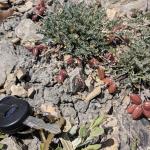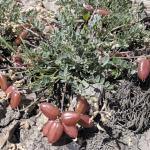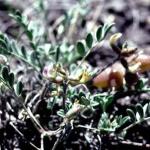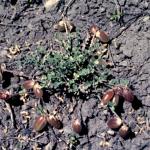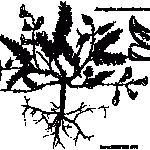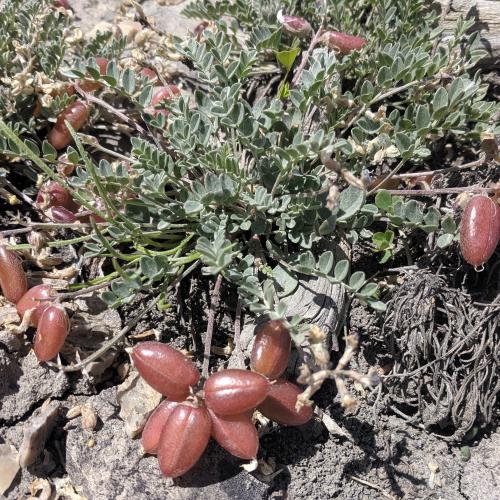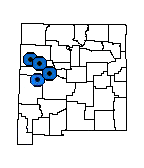Astragalus accumbens (Zuni Milkvetch)
ASTRAGALUS MISSOURIENSIS VAR. ACCUMBENS (SHELDON) ISELY; BATIDOPHACA ACCUMBENS (SHELDON) RYDBERG
| USFWS | State of NM | USFS | BLM | Navajo Nation | State Rank | Global Rank | R-E-D Code | NMRPTC Status | Strategy Status |
|---|---|---|---|---|---|---|---|---|---|
| S3 | G3 | 1-1-3 | R | SS |
| Overall Conservation Status | Documented Threats | Actions Needed |
|---|---|---|
| UNDER CONSERVED | No Information |
Status surveys on abundance, distribution and threats |
Perennial; plants low, tufted, stemless or with short stem (0-4(6) cm long), stems prostrate; herbage usually silvery; foliage densely strigose with rather coarse straight and parallel, appressed, dolabriform hairs; stipules not connate; leaves 2-6.5 cm long; leaflets 7-15, obovate to oval, 2-8(11) mm long; flower stalks slender, wiry, often long-persistent, 3-6.5 cm long, prostrate in fruit; inflorescence (3)5-14-flowered, axis little elongating in fruit; calyx 4.5-5 mm long, with mixed black and white or sometimes all white hairs; flowers pea-like; petals ochroleucous with indistinct lilac veins, or banner and wings distally tinged with dull lilac, longest petals (wings) 7.5-9 mm long; banner abruptly recurved 90-100, 7-8.3 mm long; pod spreading or ascending, long-persistent, plumply ovoid or oblong-ellipsoid, straight, 9-18 mm long, 4-7(8) mm in diameter, rounded at base, abruptly contracted at tip into a stout cusp, exterior fleshy, green, smooth, strigulose, becoming leathery, brown or black, roughly netlike, either no septum or a rudimentary one up to 1.2 mm wide, dehiscing apically and ultimately through the length of the ventral (adaxial or upper) suture, the tips curling backward and gaping to release the seeds. Flowers (March) May through June (August).
Astragalus accumbens is similar to A. missouriensis var. mimetes. They may be distinguished as follows:
A. accumbens - calyx 4.5-5 mm; corolla ochroleucous or lavender-tinged, to 9 mm; banner reflexed about 90; keel incurved 100-120; McKinley, Cibola, and Catron counties, New Mexico.
A. missouriensis var. mimetes - calyx 5-6 mm, corolla pink-purple, 9.5-11.5 mm; banner reflexed to about 45; keel incurved about 90; Cibola, Valencia and Socorro counties, New Mexico.
New Mexico, northern Catron, Cibola, and southern McKinley counties.
Gravelly clay banks and knolls, in dry, alkaline soils derived from sandstone, in piñon-juniper woodlands; 1,890-2,410 m (6,200-7,900 ft).
In the Zuni Mountains, this plant is associated with Erigeron rhizomatus, another endemic plant.
Locally abundant within its limited range. Current land uses apparently pose no threat to this species.
*New Mexico Native Plants Protection Advisory Committee. 1984. A handbook of rare and endemic plants of New Mexico. University of New Mexico Press, Albuquerque.
Barneby, R.C. 1964. Atlas of North American Astragalus. Memoirs of the New York Botanical Garden 13:1-1188.
Isely, D. 1998. Native and naturalized Leguminosae (Fabaceae) of the United States (exclusive of Alaska and Hawaii). Monte L. Bean Life Science Museum, Brigham Young University, Provo, Utah.
For distribution maps and more information, visit Natural Heritage New Mexico

